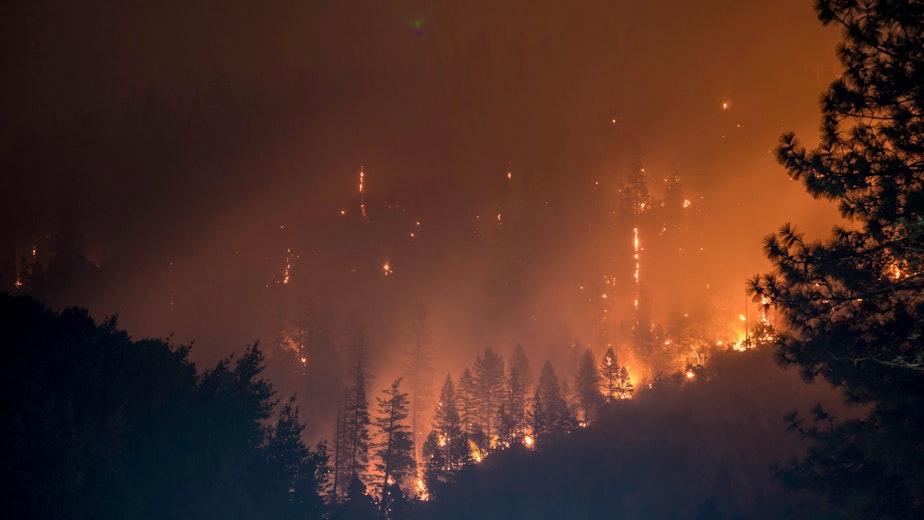Western forests face devastating consequences of climate change, wildfires

Wildfires are an increasingly dangerous threat to people, wildlife, and property in the American West, but that threat could eventually taper off. That’s not necessarily a good thing.
Maureen Kennedy is an assistant professor of wildfire and forest management at the University of Washington Tacoma. She told KUOW’s Paige Browning about her research.
This interview has been edited for clarity.
Paige Browning: In your new research, you found that the western United States is in for a burst of wildfire activity. When, and what will that burst mean?
Maureen Kennedy: If you want to consider what this burst is going to look like, or when it's going to happen, we're basically seeing that right now with the confluence of lots of fuels across the western United States, corresponding to what has been an unusually hot and dry summer. Those are exactly the conditions under which we're going to get a burst of wildfire. In different areas, you can see those coinciding to create a pulse, or a burst, of wildfire.
How long is this burst of activity going to continue?
Within the simulations, that burst was occurring within about the first decade. After that, we saw potentially reduced wildfire activity, corresponding to persistently hot and dry conditions that actually caused the vegetation not to grow as well after that burst of wildfire.
Sponsored
You're saying after 10 years of a lot of wildfire activity in the West, we could see low vegetation. What does that mean in terms of the forest, and wildfires?
I want to emphasize that this potential condition of lower vegetation would still take several decades to develop, but what this means is that in some of our dry forests they're really living on the edge. If it gets hotter and drier, if they become so drought stressed, so limited by the amount of water available, they have difficulty growing, and maintaining increased growth for the trees.
So, you have unhealthy forests that are going to develop, and we know that it's the growth of vegetation that eventually sheds the needles and the branches and the twigs that fall to the ground that create fuels that the wildfire then burns.
So you’re saying a spree of western fires will burn through vegetation, and the forest won't grow back, due to climate change?
Essentially, yes.
Sponsored
And what will that do to our future if we don't have the fires and the forests as they look now?
This is a modeling study looking very far into the future, so there’s uncertainty, but if something like this does occur, that means it could decimate the forest. It means that we're not going to have as much of the large, beautiful trees that we have now, and that those could potentially be replaced by more woodlands or shrublands or grasses, which actually creates an entirely different kind of wildfire.
In your simulations, you were able to turn the fires on and off, and turn climate change on and off. Where does fire suppression come into play? The present day strategy in the U.S. is basically to tamp down wildfires as quickly as possible.
One of the interesting things that we found out through this simulation is that if we allowed wildfire to continue on the landscape, under historical climate conditions, we had that big burst of extreme fire behavior. But then, over time, the fires actually started to take care of themselves.
These weren't controlled burns, these were burns that were just allowed to burn on the landscape, but they did manage the fuels in a way that actually maintain a healthy overstory, a healthy tree canopy, and the fires were still getting smaller over time.
Sponsored
Of course, we don't necessarily want these fires to be burning as wildfires, but we could substitute some controlled burns, under controlled conditions, that can minimize and mitigate damage to the landscape, damage to people's property, that can minimize and mitigate smoke impacts and air quality impacts, and still have that condition where the fuels are being managed through a relatively natural process of fire management.
So your simulation found that if we let the wildfires just run, it actually brings back a healthy tree canopy, and setting purposeful controlled burns would have the same impact.
Yes.
Where do you go next with this research or what more do we need to know about it?
What I find to be most interesting about this research is that it really gives us a direction to look in when we're trying to understand what the ultimate combination of wildfire and climate change is going to be for our forests. The way I like to think about it is that every place tells its own story.
Sponsored
This simulation occurred in the Sierra Nevada mountain range in California. We'd really like to understand what other kinds of behaviors and other kinds of dynamics we might find, say, in eastern Washington, or in some of the mountain forests in Arizona, or in Oregon. Each one is going to have its own intricate relationship between what climate change is going to do to wildfire, and what climate change is going to do to the vegetation, and ultimately, then what the fuels do to wildfire.
Really, it's a very intricate web of interactions that might differ from place to place. We want to expand our studies to understand better what might happen in all these different areas.
Listen to the interview by clicking the play button above.





